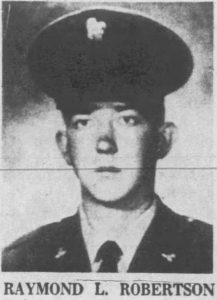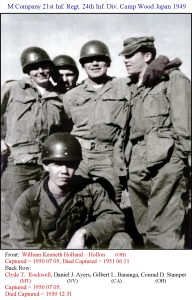Henry John Fouracres, age 27, from Silver Bow County Glastonbury, Montana .
Parents: Henry S. Fouracres
Service era: Korea
Schools: Saint John’s School in Glastonbury
Date of death: Thursday, November 30, 1950
Death details: By mid-November 1950, U.S. and Allied forces had advanced to within approximately sixty miles of the Yalu River, the border between North Korea and China. On November 25, approximately 300,000 Chinese Communist Forces (CCF) “volunteers” suddenly and fiercely counterattacked after crossing the Yalu. The 2nd Infantry Division, located the farthest north of units at the Chongchon River, could not halt the CCF advance and was ordered to withdraw to defensive positions at Sunchon in the South Pyongan province of North Korea. As the division pulled back from Kunu-ri toward Sunchon, it conducted an intense rearguard action while fighting to break through well-defended roadblocks set up by CCF infiltrators. The withdrawal was not complete until December 1, and the 2nd Infantry Division suffered extremely heavy casualties in the process. Sergeant First Class Henry John Fouracres, who joined the U.S. Army from Montana, served with the Headquarters, Headquarters and Service Company, 2nd Engineer Combat Battalion, 2nd Infantry Division. He went missing in action during his unit’s withdrawal from Kunu-ri to Sunchon. No one saw him fall, and his body was not recovered after the battle. He was not reported to be a prisoner of war, and his remains were not among those returned by North Korea. Sergeant First Class Fouracres is memorialized on the Courts of the Missing at the National Memorial Cemetery of the Pacific.
Source: National Archives, Defense POW/MIA Accounting Agency, Central Somerset Gazette (1954)



 Death details: On July 5, 1950, Task Force Smith, the first U.S. ground element to engage North Korean People’s Army (NKPA) troops, was defending a position north of Osan, South Korea. The Task Force’s goal was to delay enemy forces by blocking their movement down the road south from Suwon to Taejon, which was a major avenue of advance for the NKPA. That morning, the Task Force was engaged by a column of enemy tanks. The anti-tank weapons that the infantrymen employed were ineffective, and a large number of tanks broke through their position. Task Force Smith was forced to withdraw to the south, suffering heavy casualties in the process. Corporal Clyde Thomas Rockwell, who joined the U.S. Army from Montana, served with M Company, 3rd Battalion, 21st Infantry Regiment, 24th Infantry Division. His unit was part of Task Force Smith, and he was captured by enemy forces on July 5 and forced to march to the Apex prison camps in North Korea. He died of malnutrition and dysentery at the camp at Hanjang-ni on an unspecified day in late 1950, and was buried near the village. His remains were not identified among those returned to U.S. custody after the ceasefire, and he is still unaccounted for. Today, Corporal Rockwell is memorialized on the Courts of the Missing at the National Memorial Cemetery of the Pacific.
Death details: On July 5, 1950, Task Force Smith, the first U.S. ground element to engage North Korean People’s Army (NKPA) troops, was defending a position north of Osan, South Korea. The Task Force’s goal was to delay enemy forces by blocking their movement down the road south from Suwon to Taejon, which was a major avenue of advance for the NKPA. That morning, the Task Force was engaged by a column of enemy tanks. The anti-tank weapons that the infantrymen employed were ineffective, and a large number of tanks broke through their position. Task Force Smith was forced to withdraw to the south, suffering heavy casualties in the process. Corporal Clyde Thomas Rockwell, who joined the U.S. Army from Montana, served with M Company, 3rd Battalion, 21st Infantry Regiment, 24th Infantry Division. His unit was part of Task Force Smith, and he was captured by enemy forces on July 5 and forced to march to the Apex prison camps in North Korea. He died of malnutrition and dysentery at the camp at Hanjang-ni on an unspecified day in late 1950, and was buried near the village. His remains were not identified among those returned to U.S. custody after the ceasefire, and he is still unaccounted for. Today, Corporal Rockwell is memorialized on the Courts of the Missing at the National Memorial Cemetery of the Pacific.